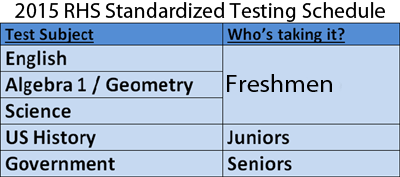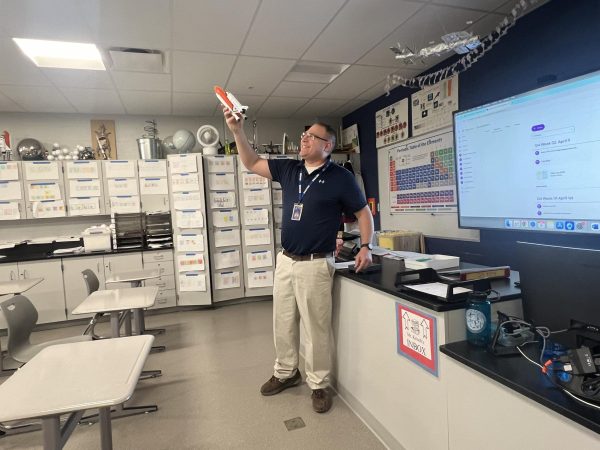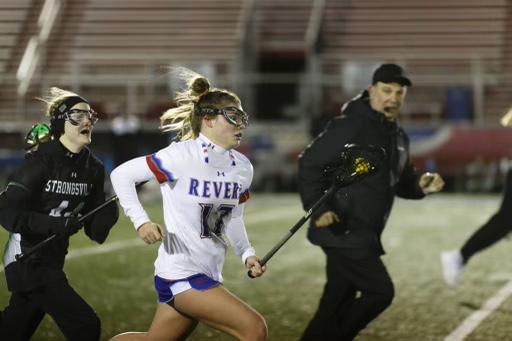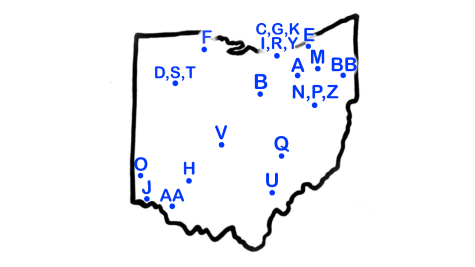State of Ohio, Revere Local Schools adopt new form of standardized tests

Freshman Andrew Lucas works on a Chromebook to prepare for the PARCC test.
This spring, students across Ohio will log onto a computer, sit down, and start a form of testing new to them: the PARCC and AIR tests.
The new tests will replace the current standardized tests in the state of Ohio, known as the Ohio Achievement Assessments (OAAs) and Ohio Graduation Tests (OGTs). Students will take these tests on computers at Revere and across the state twice per year, once in March and again in May, to assess their proficiency in several areas of study.
Students’ proficiency in math and language arts will be determined by a test developed by a company known as Partnership for Assessment of Readiness for College and Careers (PARCC). The tests will bear the name of their developing company. Proficiency in science and social studies will be determined by a set of tests that was developed by the American Institutes for Research (AIR). The state of Ohio requires such tests for a school district to receive government funds.
The tests will begin in the third grade, and students will take at least one test every year until graduation. Revere Local Schools Curriculum Director Maggie Niedzwiecki commented on the process that students will go through for these tests.
“The PARCC math and language arts tests took over the OAA math and language arts tests [in grades] 3-8, and also they took over the math and language arts portion of what the OGT would have been at the high school,” Niedzwiecki said.
At the high school, the tests will replace the OGT. Revere High School Principal Phil King explained the process in his building.
“[The new] testing is taking place during OGT week, [March] sixteenth through the twentieth . . . [the second set of tests] will be taken the week after spring break … and those will be during [students’] regular class periods. If a [student] does not have that actual class [at that time], we will have to call them in and [the student will test] in the library, and they will have different times [to test] during an elective course,” King said.
The new tests have several differences from their predecessors. Niedzwiecki explained that the major differences she has observed so far are that the new tests, outside of being online, have fewer questions than the OAA and the OGT.
One similarity the new tests will share with the tests they are replacing is the fact that a high school student must pass them in order to graduate. There are a series of seven tests a student must now pass in order to receive a diploma in the state of Ohio: two in language arts; two in math; two history tests, one in Government and one in United States History; and a science test — this year’s will be Physical Science but [the subject] is slated to change to Biology.
The first class that is required to take all of these new tests at Revere High School will be the graduating class of 2018. The classes of 2017, 2016 and 2015 will utilize the OGT. King explained the requirements.
“The students that are sophomores, juniors and seniors are under a different requirement for graduation. The only ones that have a requirement for graduation to take the [new] assessments are the freshmen, except for the social studies courses, US History and Government,” King said.
Passing the tests is not the only way a student can attain a high school diploma, however. Niedzwiecki explained the other methods.
“In the state of Ohio, the law changed so that you can also now get a diploma by either by a certain score on the ACT or a technical career licensure. So there are three avenues to get diplomas in Ohio,” Niedzwiecki said.
The score needed on the ACT to attain a diploma has yet to be determined.
The tests are split into two different variations. Students will take the performance-based tests in March, and the end-of-year tests in May. Niedzwiecki explained how these two tests will be combined to gauge student achievement.
“[Those two tests] together are called an end of course test. So, it is taking those two scores and putting them together, and giving a student score for the year,” Niedzwiecki said.
Advanced Placement (AP) students can be exempted from the end-of-course exam if they choose to take the test that accompanies their course.
Students who do choose to take the AP test will not be required to attain a certain score in order for their test to count as an exemption from the end-of-course exam. These new tests were developed by educators from several states to create a series of national standards for students to meet. They were not entirely developed around Common Core, as Niedzwiecki pointed out.
“Common Core is only language arts and math . . . a lot of people think Common Core means science and social studies too. We have always had national standards; a lot of high-achieving schools like [Revere] latch on to those national standards,” Niedzwiecki said.
Revere has taken the first round of tests, and Niedzwiecki explained that the rollout was primarily smooth.
“For our teaching staff, it has been a little . . . difficult because we do not always utilize the tools that are on [computers], and students are more calm about computer access because that is their world they’re living in. I think [administratively] it is easier-run on a computer, because when you do testing for a school district of 2500-2700 [students], you receive multiple boxes that have to come in and out of the district to be resent back to the state for scoring,” Niedzwiecki said.
The change to a new testing format has not been without drawbacks, however. One such disadvantage is the possibility for a schedule conflict at Revere. Students who take a one-trimester course in the first or third trimester may be at a disadvantage compared to those who have taken it earlier or later in the year. Students who have the class in the third trimester only will be tested over the entirety of the course, despite only having been taught part of the class. According to King, students are supposed to have taken about 75 percent of a class by the time they take their first test, but under the current schedule roughly 40 percent of the class will have been completed. Students who have taken the class in the first trimester will be taking a test over material they have not seen in several months. This conflict may only exist for one year, however, as Niedzwiecki explained.
“When [one] turns over to new testing, [one] has to normalize the scores. So this year, everyone had to test at the same time so that the state can normalize the scores over the summer. That always happens when [one] does new testing. Our schedule does not fit that model, and it does not fit other schools’ model either. Online testing is supposed to be able to allow us to test whenever our courses finish. So this might be the only year that the conflict happens . . . if our course is only at one trimester or two trimesters, we will adjust when we test,” Niedzwiecki said.
King explained that there may be a schedule change in the future, stating that testing when only a portion of a class is complete is not helpful.
Educators have reacted to the change, which King elaborated on.
“[Reactions] run the gamut. There are those who are opposed to the [new] testing, and then we have those who think nothing of it; that it is just another hoop we have to jump through for our [students] to be successful,” King said.
The new tests will begin this spring, and are designed to replace the OAA and OGT. Students in grades ranging from elementary school to high school seniors will take some form of the online test in a variety of different subjects. Students must pass the tests in order to receive a diploma, but there are other avenues to graduate if necessary. The switch has created some problems within the district, but Revere administrators will attempt to make the transition as smooth as possible.
 Infographic by Aristotle Kayafas
Infographic by Aristotle Kayafas















